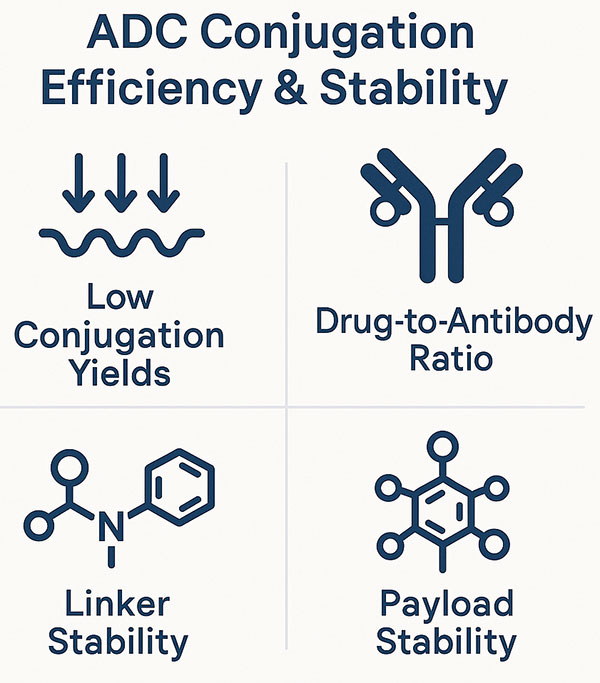Antibody-drug conjugates (ADCs) represent an innovative cancer treatment approach that merges monoclonal antibodies targeting precision with highly toxic therapeutic drugs. ADC conjugation efficiency measures how effectively antibodies attach to cytotoxic drugs throughout the ADC drug development stage. The procedure demands exact chemical reactions while also guaranteeing a uniform and stable linkage between the antibody and the drug. The conjugation efficiency level determines both the yield and ADC quality, which in turn influences their clinical application effectiveness.
Multiple steps make up the ADC conjugation process, which includes antibody modification and cytotoxic drug activation before linking them together. The efficiency of conjugation during this process depends on multiple aspects, including the conditions of the reaction as well as the chemical characteristics of both the antibody and drug, together with the method used for conjugation. Optimal conjugation processes achieve high production yields of ADCs by maintaining the number of drugs attached per antibody molecule (drug-to-antibody ratio, DAR) within the target range.
 Fig. 1. Factors affecting the conjugation efficiency and stability of ADCs (BOC Sciences Authorized).
Fig. 1. Factors affecting the conjugation efficiency and stability of ADCs (BOC Sciences Authorized).
Successful clinical application of ADCs requires high stability levels. The structural and functional integrity of a stable ADC persists in the body until it delivers the drug at the designated target tissue. Premature degradation or instability of the ADC in the body leads to non-specific drug release, which can trigger severe side effects, including immune responses and toxicity to healthy tissues. ADCs that lack stability can alter their distribution and pharmacokinetic properties, which leads to decreased therapeutic efficacy. ADC stability requires evaluation of several elements, including the durability of the antibody component, the linker, and the cytotoxic drug. The chemical bond known as the linker connects the antibody to the drug, and its stability controls the ADC's integrity throughout systemic circulation. The activity of the cytotoxic drug during storage and transportation relies on its stability. The stability of ADCs must be guaranteed to enable effective and secure therapeutic applications.
Low conjugation yields and inconsistent results are common problems in the ADC conjugation process. These issues may be caused by various factors, such as suboptimal reaction conditions, poor quality of antibodies or drugs, and improper selection of conjugation methods. For example, if the reaction time is too short or the temperature is too low, it may lead to incomplete linkage between the antibody and drug, thereby reducing conjugation yields. Additionally, insufficient purity of the antibody or drug may also affect conjugation efficiency, leading to inconsistent results.
To resolve the problems of low conjugation yield and inconsistent outcomes, multiple approaches are needed. First, the reaction conditions such as temperature, time, and pH must be optimized to ensure that the antibody and drug can couple under ideal conditions. Second, strict quality control of the antibody and drug is required to ensure their purity and activity. Finally, the selection of an appropriate conjugation method and linker is also crucial, as different linkers may have varying impacts on conjugation efficiency.
The DAR is one of the key factors influencing ADC performance. The ideal DAR typically ranges between 2 and 4, meaning that each antibody is linked to 2 to 4 drug molecules. However, in practice, over-conjugation (high DAR) or under-conjugation (low DAR) may occur during the conjugation process. Over-conjugation may result in reduced ADC solubility, increased immunogenicity, and rapid drug release, which can affect therapeutic efficacy and safety. Under-conjugation may lead to insufficient drug potency, failing to effectively kill cancer cells.
Therefore, maintaining the DAR within the ideal range is a crucial goal in ADC development. This requires precise stoichiometry and optimized conjugation conditions to ensure uniform drug-to-antibody linkage. In addition, analytical methods such as mass spectrometry are needed to accurately measure DAR, allowing timely adjustment of the conjugation process.
Achieving the ideal DAR is a complex challenge in ADC development. DAR optimization requires not only consideration of the chemical properties of the antibody and drug but also the choice of linker and conjugation method. Different linkers and conjugation strategies can result in varying DAR distributions, necessitating experimental validation to determine optimal conditions.
Moreover, DAR optimization must also take into account the biological characteristics of ADCs. For instance, high DAR may increase immunogenicity, triggering immune responses, while low DAR may result in inadequate efficacy. Therefore, optimizing DAR requires a comprehensive consideration of both chemical and biological factors to ensure the safety and effectiveness of ADCs.
| Conjugation Type | Service Description |
| Bispecific Antibody Conjugation | We provide customized conjugation strategies for bispecific antibodies to enable targeted and dual-antigen ADC development. |
| Carbohydrate Conjugation | Our carbohydrate conjugation service utilizes glycan engineering to achieve site-specific and stable ADC formation. |
| Click Chemistry Conjugation | We offer highly efficient and selective click chemistry conjugation for rapid and reproducible ADC assembly. |
| Cysteine Conjugation | Our cysteine-based conjugation enables controlled drug-to-antibody ratios through thiol-specific coupling techniques. |
| Enzymatic Conjugation | We apply enzyme-mediated conjugation methods for precise and mild site-specific ADC modifications. |
| Lysine Conjugation | Our lysine-targeted conjugation platform ensures robust and scalable ADC production using established amine-reactive chemistries. |
| Non-natural Amino Acids Conjugation | We incorporate non-natural amino acids into antibodies for orthogonal and site-selective ADC payload attachment. |
| Site-Specific Conjugation | Our site-specific conjugation solutions deliver consistent ADCs with defined structures and improved therapeutic indices. |
| Tyrosine Conjugation | Our tyrosine conjugation technology allows selective payload attachment at exposed phenolic sites for enhanced ADC stability. |
Linkers play a critical role in the stability of ADCs. They are the chemical bonds connecting the antibody to the cytotoxic drug, and their stability determines the integrity of the ADC during systemic circulation. Ideally, a linker should remain stable during blood circulation but be specifically cleaved upon reaching the target tissue to release the drug. The stability of linkers is influenced by several factors, including their chemical structure, bonding method, and interactions with the antibody and drug. For example, some linkers are more readily cleaved in acidic environments, which is advantageous for drug release in tumors that typically have an acidic microenvironment. However, if the linker is also easily cleaved in neutral environments, it may lead to non-specific drug release and cause side effects. Thus, selecting an appropriate linker is a key strategy for ensuring ADC stability. Researchers are developing various novel linkers to enhance both stability and specificity. For instance, some new linkers can be cleaved enzymatically, improving drug release efficiency in tumor tissues while minimizing toxicity to healthy tissues.
The stability of the cytotoxic drug (payload) and its release mechanism are also crucial factors affecting ADC stability. The cytotoxic drug must maintain its activity during storage and transportation and remain stable during circulation in the body until it reaches the target tissue and is specifically released. The release mechanism of the cytotoxic drug is often closely related to the stability of the linker. For example, some linkers can be cleaved by specific enzymes to release the drug. This enzymatic release mechanism can enhance drug delivery efficiency in tumor tissues while reducing toxicity to normal tissues. However, if the linker lacks sufficient stability, it may result in non-specific drug release and trigger adverse effects. Therefore, ensuring the stability of the cytotoxic drug and optimizing its release mechanism are key goals in ADC development. Researchers are exploring various combinations of new cytotoxic drugs and linkers to improve ADC stability and therapeutic performance.
The storage and formulation conditions of ADCs also significantly impact their stability. ADCs typically require storage under low temperature and light-protected conditions to prevent degradation of cytotoxic drugs and cleavage of linkers. Additionally, formulation conditions such as pH, buffer composition, and concentration also affect ADC stability. For example, certain cytotoxic drugs may degrade more easily in acidic or alkaline environments, necessitating the selection of suitable buffers to maintain stability. Moreover, excipients in formulations may also influence ADC stability. Some excipients may interact with the cytotoxic drug, leading to degradation or reduced activity. Therefore, optimizing the storage and formulation conditions of ADCs is a key strategy to ensure their stability. Researchers need to validate optimal conditions through experiments to extend ADC shelf life and enhance their overall stability.
| Linker Type | Description |
| Acid Cleavable Linkers / Hydrazone Linkers | Designed to release payloads in acidic environments such as tumor endosomes. |
| Disulfide Linkers | Cleaved in reductive intracellular conditions, enabling selective drug release. |
| Cathepsin B Cleavable Linkers / Peptide Linkers | Enzyme-sensitive linkers cleaved by cathepsin B for tumor-specific activation. |
| Phosphatase Cleavable Linkers | Triggered by elevated phosphatase levels in tumor cells for controlled release. |
| Sulfatase Cleavable Linkers | Cleaved by sulfatases overexpressed in certain tumor types for targeted delivery. |
| β-Galactosidase Cleavable Linkers | Enzyme-activated linkers responsive to β-galactosidase in cancer microenvironments. |
| β-Glucuronidases Cleavable Linkers | Activated by β-glucuronidases abundant in tumor lysosomes for efficient payload release. |
Optimizing linker chemistry is one of the key strategies to improve ADC conjugation efficiency. The chemical properties of the linker directly affect the efficiency and stability of the connection between the antibody and the drug. By designing and synthesizing novel linkers, conjugation efficiency can be improved and side reactions can be minimized. For example, some new linkers can form covalent bonds with both the antibody and the drug, thus enhancing conjugation efficiency. In addition, novel linkers can be optimized in terms of their chemical structure to improve stability and specificity. For instance, certain linkers can be cleaved under specific enzymatic conditions, thereby enhancing drug release in tumor tissues while reducing toxicity to normal tissues. Researchers are continuously exploring and developing new linkers to improve ADC conjugation efficiency and stability. Through the optimization of linker chemistry, higher conjugation yields and ideal drug-to-antibody ratios (DAR) can be achieved, ultimately enhancing the therapeutic efficacy and safety of ADCs.
Controlling the drug-to-antibody ratio (DAR) is a critical goal in ADC development. The ideal DAR range is typically between 2 and 4, meaning that each antibody is conjugated with 2 to 4 drug molecules. However, over-conjugation or under-conjugation may occur during the actual conjugation process. Therefore, advanced techniques are required to precisely control DAR. For example, some researchers are developing novel conjugation methods, such as site-specific conjugation, which enables precise DAR control by linking drugs to specific sites on the antibody through defined chemical reactions. Furthermore, optimized conjugation conditions and appropriate linker selection can lead to more desirable DAR distributions. Researchers are also exploring other advanced techniques for DAR control, such as mass spectrometry and high-performance liquid chromatography (HPLC), which can provide accurate DAR measurements and assist in real-time optimization of conjugation processes to achieve the target DAR.
Tailored conjugation strategies for specific therapeutic targets represent another important direction for enhancing ADC conjugation efficiency and stability. Different therapeutic targets may require different combinations of antibodies and drugs, making it essential to design and optimize conjugation strategies based on specific application requirements. For example, some tumor cells may express unique antigen patterns that necessitate the selection of antibodies capable of specifically recognizing those antigens. Additionally, the selection of cytotoxic drugs must align with the biological characteristics of the tumor cells. For instance, certain tumor cells may be more sensitive to specific cytotoxic drugs, requiring careful drug selection to maximize therapeutic effects. Researchers are developing various tailored conjugation strategies to address diverse therapeutic needs. By customizing conjugation strategies to specific therapeutic targets, higher conjugation efficiency and more desirable DARs can be achieved, thereby improving the therapeutic efficacy and safety of ADCs.
BOC Sciences is committed to delivering high-quality ADC products and customized services. Our ADCs undergo rigorous quality control and testing to ensure superior performance in terms of conjugation efficiency, stability, and therapeutic efficacy. We provide one-stop services ranging from antibody design to drug conjugation, tailored to meet your specific project requirements. Our professional services include:
From cytotoxins to linkers, explore our cutting-edge products for your ADC project.
| Catalog | Name | CAS | Price |
| BADC-00008 | Val-Cit-PAB-MMAE | 644981-35-1 | Inquiry |
| BADC-00016 | Vat-Cit-PAB-MMAD | 1415329-13-3 | Inquiry |
| BADC-00013 | MC-Val-Cit-PAB-MMAF | 863971-17-9 | Inquiry |
| BADC-00364 | Fmoc-Val-Cit-PAB | 159858-22-7 | Inquiry |
| BADC-00708 | Val-cit-PAB-OH | 159857-79-1 | Inquiry |
| BADC-00501 | Mc-Val-Cit-PABC-PNP | 159857-81-5 | Inquiry |
| BADC-00698 | Boc-Val-Cit-PAB-PNP | 870487-10-8 | Inquiry |
| BADC-00409 | Azido-PEG2-NHS ester | 1312309-64-0 | Inquiry |
| BADC-00453 | Mal-PEG2-NHS ester | 1433997-01-3 | Inquiry |
| BADC-01482 | Fmoc-Val-Ala-OH | 150114-97-9 | Inquiry |
Explore our advanced tools and expertise for next-generation ADC research and development.
Designed to release the drug under specific intracellular conditions such as pH, enzymes, or redox.
Remain stable and release the drug only after complete degradation of the antibody.
Provides quantitative analysis of ADC components using advanced LC-MS/MS and immunoassay techniques.
Assesses the in vivo tissue and plasma distribution of the released payload and intact ADC.










